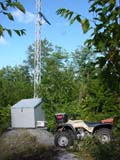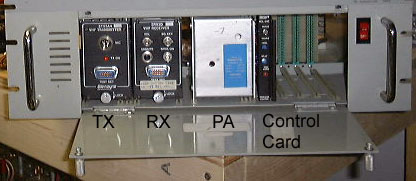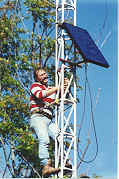


Technical Information
by VE3TK



Technical Information
by VE3TK
Repeater as of October 10th, 2020
VHF repeater is on-the-air. One guy-wire turnbuckle broke while tightening, and replaced. Lots of tree's South of the tower dropped to ensure solar panels get winter sun. Brush clearing. Bear teeth marks on 1/2" Heliax simply taped up. 2011 battery replaced with newer. Surprisingly, 2011 battery still functions as a good battery, with slightly diminished capacity. APRS was working for a month, but removed to get some more electrical tweaks. tk
Repeater as of October 5th, 2013
Repeater stopped working last year. Most equipment was removed for refurbishment. No fault found in the radios. Top mounted Hustler fiberglass antenna had failed and eventually half of it was found on the ground due to fiberglass fatigue. On Sept 28th, 2013, new VHF multicoupling was installed to support 3 frequencies on the 210-C2 antenna. A UHF 310-C4 antenna was installed on the tower for future use. A new APRS Digipeater using an OpenTracker 2, GE MPI portable and external 25W PA was installed and are working great. Solar charge controller exhibits excessive voltage drop which creates issues for the repeater stability so must be replaced during the next visit and voice repeater put back in service. Tightened up the tower guy wires using the turnbuckles. Guy wires do show some rust at the top. Anchors seem secure. I'm typing this so the tower survived the climb and work. Lots of dead ladybugs but no other environmental issues. tk
November, 2011: After 10+ years, the insulation jacket for the solar panel DC wire was cracking due to UV exposure. This was replaced with UV stable DC cable consisting of #10 AWG wire and a braided shield. A new 50W Solarex panel has been purchased from Generation PV and is installed higher on the tower and electrically parallel with the older 40W panel. APRS telemetry on 144.390 MHz was added. Opentracker module - one way only, no digipeater.
Over the years, we have had no shortage of environmental snags, from porcupines, carpenter ants, and lady bugs. Metal cladding has resolved the porcupine issue. Foam insulation (ants nest in it) has been removed. A seal will have to be installed around the lid to keep out insects (Ladybugs, wasps, spiders).
The solar panel has an adjustable mount for summer/winter angle adjustment. We have found no appreciable difference in output power, so it is kept in the winter angle. This aids with snow and frost shedding. Due to the low repeater idle current, overcast weather (during Ontario winters can last 5 days or more) has not been an issue. As for snow cover, the lower panel has a steeper angle to accelerate shedding.
Bush and tree growth at the site and the access ATV trail is a constant maintenance issue.
Equipment Particulars
Receiver: Glenayre Mountain Top 3R93D receiver + Motorola Mitrek Preselector with 6 dB preamp. Receive sensitivity for 12dB SINAD is -122 dBm!
Transmitter: Glenayre Mountain Top 3T93A4 exciter set to 3W. PA is transplanted from a GE Portamobile 2 into a high stab oscillator case so it plugs into the backplane. A small fan was added. Set to 25W.
Both receiver and transmitter have been retuned down from mid or high splits. All alignment done for 0�C and tested stable from -20�C to +20�C. As the receiver gets colder, the squelch gets slightly tighter by a dB, thus ensuring stable operation.APRS radio is a portable GE MPI. It is a synthesized radio with excellent power consumption characteristics for a solar site. Connected to a 30W external PA and OpenTracker 2 in digi mode. A lot of time on the bench was required to find the bugs with OT2 to have it operate as a stable digi. It been set up for WIDE1&2 day mode and Wide1 only for night mode or when solar is not available.
Controller: NHRC-2 Repeater Controller is a simple home-built PIC based controller. It is providing recorded voice ID and time-out messages. The actual voices you hear are synthesized. A Glenayre RLC-54C card is the backup audio control card that is native to this radio package. If the NHRC-2 dies or is removed, a switch can be flipped to keep the repeater on-the-air.
APRS controller is Opentracker+ (version 2). Coordinates are fixed (no GPS). The radio power is controlled by the Opentracker and is off when on standby, turned on 3 seconds before transmission, the shut down again after the hourly telemetry packet is sent. During the 3 second receive time, 144.390 MHz activity is monitored while a gap is sought for the burst. The possibility exists to convert this to a an APRS digi using an Opentracker2 controller (already on my bench being tested).
Filters: Sinclair 2 BR cavities + 1 BP cavity per side. This is a minimal insertion loss configuration usable due to separate TX/RX antennas. A Sinclair band pass filter tuned for 0.5db was added to the APRS transmitter for control of transmitter noise that could potentially affect the voice repeater.
Antenna: Transmit is a Sinclair 210-C2, 1/4 wave spaced dipoles at 67' elevation favouring a NW direction (6 dBd gain). Receive is a Hustler VHF/UHF 6dBd omni top mounted at 80' AGL. The dual antenna configuration is providing 47 dB of isolation between TX and RX allowing the repeater to operate with minimal duplexing loss and maximum receiver sensitivity. The difference in TX and RX antenna patterns isn't an issue for desired mobile coverage or OMNI portable coverage. APRS antenna is a quarter wave at 50'. Decided for a separate APRS antenna rather than multicoupling to the voice repeater antenna to maintain minimal insertion loss.
Transmission line: Two lines of Andrew Heliax LDF4-50A (1/2"). All transmission line connectors are type N female. APRS uses LMR400.
Current Consumption: 52mA on RX/standby; 4.5A on transmit for voice. APRS uses 9mA on standby (Opentracker turns off the radio), 27mA receiver on, and 1.2A on transmit.
Solar Power System: A 40W and 50W Solarex panels sold by Generation PV provides 2.3A + 3.2A = 5.5A of current at full sunlight. The panel is mounted on the tower at 25' and 35' AGL facing due south. New charge controller is Steca 12A with PWM, temperature compensation, load disconnect and LCD display. Battery (2011) is an Enersys SBS170 (AGM/VRLA 12V 170 Ahr).
Tower: Sampson guyed tower. Total height is 70' + 10' mast + 7' antenna = 87' AGL of 1587' AMSL. It is anchored on granite rock with threaded rod and construction epoxy. It was obtained used, and painted (Tremclad is great!) for this installation. As of 2007, some of the drain holes in the tower sections are showing signs of rust. The guys are 3/16" aircraft cable. As of 2007, they are brown but rust is not significant. In 2006, a tornado passed within 2 kilometers of this tower, and many other windy storms have been encountered. So far, so good.
Enclosure: A "sand box" was constructed out of 3/4" plywood. It has one shelf in it for the radio package. After ants and porcupines had fun with the painted plywood, the box was steel clad. No problems since, however, a better seal is required to keep wintering Lady Bugs and other flying insects out.
Environment: Forest with lots of Poplar trees and Rasberry bushes. Winter temperatures typically -5C to -40C. Summer temperatures +15C to +35C. Summer temperatures in the box may be higher for a few hours on a hot day.
Previous Equipment Configurations
Previous radios used at this site include Motorola MTR300 (MX portable based) Mountain Top Repeater, and R.C. Electronics BR-150 (PT200 portable based) mountain top repeater. A stand alone 25W GE Portamobile 2 transmitter was once used with a Motorola MX300 receiver. We have tried various 30W PA's with these transmitters for greater RF power.
Batteries were swapped out simply due to age, not failure. The original battery (1994 to 2000) was Johnson Controls Dynasty 12V/90Ah (GELL). once removed, a discharge test on the Dynasty battery indicated it could still provide 65 Ah (down to 10.5V with a 6 hour discharge), which is very good after 6 years of cyclic duty! Second battery (September 2000 to November 2007) was an Oldham/Hawker 12HI105 (AGM/VRLA 12V, 105 Ah) which tested to have only 20 AHr capacity left at retrirement. The charge controller for these was a simple FET based device that applied charge current at 13.5V, turning it off at 14.0V. It was not temperature compensated so it has been set for an optimal year round value. Enersys 12V155FS served from 2007 to 2011.
Previous controllers used at this site have been Link Communications RLC-1 which is a 2-port device, and NHRC-2 Repeater Controller which is excellent for basic functionality, cost ($60), voice recorder, build-your-own, simplex repeater, plaything. NHRC also provide the source code so you can customize the PIC based controller for your own purposes.
Mail to: VE3TK at qsl dot net
Your comments, or questions are appreciated. Do you have a solar powered site? Drop us a note!
Back to VA3PLA home page